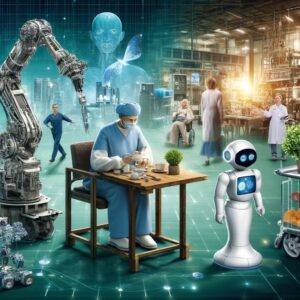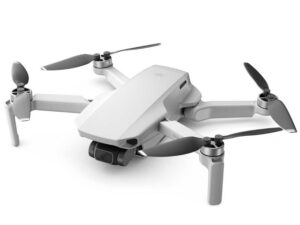Trends in Robotics in 2024-2025.The field of robotics is developing at an astonishing rate, and 2024–2025 will likely signal a paradigm shift in the way humans engage with automation and robots. Robotics is coming of age, becoming increasingly sophisticated, effective, and integrated into many industries, from manufacturing and healthcare to daily life. Let’s examine the main developments, trends, and possible effects of robotics in 2024–2025.
Key Trends in Robotics
Some key trends in robotics that are very important and crucial for improvement and advancement of Future Robotics.
AI-Powered Robotics

- Smarter Machines: Artificial intelligence (AI) is empowering robots to learn from their surroundings, make decisions, and carry out intricate jobs. Because AI-driven robots are able to adjust to changing circumstances, they are more effective in dynamic settings such as homes, hospitals, and even retailing positions.
- Natural Interactions: As NLP (natural language processing) advances, robots are able to comprehend and react to human speech in a more natural way. This makes interactions between people and robots more fluid.
Robots in Healthcare
- Robots used in surgery: Robotics in operation is becoming less intrusive and more exact. While some surgical robots, such as the da Vinci system, have been in use for some time, more advanced models are now being developed that can carry out increasingly complicated procedures with little assistance from humans, speeding up recovery and enhancing patient outcomes.
- Assistive Robots: These devices are becoming more and more common in the rehabilitation and care of the elderly. Their assistance with mobility problems, medicine reminders, and even companionship all help patients live better lives.
Robotics in Manufacturing and Industry 4.0
- Robotics is essential to Industry 4.0’s “smart factories,” which employ networked robots to improve manufacturing procedures. By taking on risky jobs, these robots can increase safety, lower expenses, and improve efficiency all around the clock.
- Collaborative robots: often known as cobots, are industrial robots that are made to work side by side with humans on the manufacturing floor. They are perfect for jobs requiring a blend of human skill and robotic precision since they are outfitted with cutting-edge sensors to guarantee safe interaction.

Autonomous Vehicles and Drones
- Self-Driving Cars: With further testing on public roads, autonomous cars are becoming more dependable. Self-driving automobiles, trucks, and shipping robots should become more common by 2024–2025, potentially revolutionising transport, logistics, and delivery services.
- Drones in Daily Life: Drones are utilised for a wide range of tasks, including package delivery and aerial photography. Drones in agriculture monitor crops, assess soil quality, and even sow seeds, increasing farming’s productivity and sustainability.
Service Robots in Daily Life
- Household Robots: As technology advances and costs come down, so do robots that help with everyday tasks like cooking, cleaning, and even child care. Soon, owning an intelligent home assistant or a robot hoover will be just as ordinary as owning a smartphone.
- Retail & Hospitality: Today’s retail establishments, hotels, and restaurants employ service robots to assist clients, bring room service, and perform other repetitive duties. This allows human employees to work in more intricate and engaging positions.
Robotics in Education
- Robots as Learning Tools: Students are being taught STEM subjects, robotics, and programming through interactive educational robots. They offer practical learning opportunities, which increase the accessibility and interest of difficult subjects.
- Assistive Learning Robots: By delivering individualised learning experiences, enhancing communication, and supplying emotional support, these robots assist kids with special needs and promote inclusivity in school.
Advances in Robotic Dexterity and Perception
- Enhanced Sensitivity: Robots are now more responsive to the touch, stress, and even temperatures thanks to advancements in sensors and actuators. This enables them to carry out delicate jobs with more precision, like handling fragile objects or supporting procedures.
- Better Navigation: For applications like self-driven cars and warehouse robots, improved machine perception and vision systems allow robots to navigate complicated surroundings more safely and effectively.

Ethical and Regulatory Considerations
- Ethical AI: As AI-powered robots proliferate, worries about privacy, employment displacement, and their ethical application are intensifying. Putting the right laws in place and ensuring that robotics are used responsibly will be a major priority for 2024–2025.
- Regulatory Frameworks: To guarantee safety, security, and moral standards, governments and organisations are developing frameworks to control the use of robots, notably in fields like health and autonomous driving.
Conclusion
In 2024–2025, robotics has the potential to significantly alter a number of facets of our daily lives. Robots have grown more advanced, capable, and socially integrated in everything from smart industries to healthcare and everyday life. The future is full of opportunity, but it also presents difficulties with regard to morality, employment displacement, and legal frameworks. However, robotics can improve human capacities, increase productivity, and pave the way for a future in which people and robots collaborate to build a better world if developed and used responsibly.
FAQs
-
Will robots take over jobs in the future?
While robots are likely to automate some repetitive and hazardous tasks, they will also create new job opportunities, especially in fields like robotics engineering, maintenance, AI development, and more. The key is to adapt and learn new skills that complement the capabilities of robots.
-
Are robots safe to use in healthcare?
Absolutely, as long as they are operated by qualified personnel, robots in the healthcare industry are generally safe. With great success rates, they have been utilised for years in patient care and procedures. But in order to guarantee safety, like with any technology, appropriate laws and supervision are necessary.
-
How will robotics affect daily life?
Robotics will make daily life more convenient by handling mundane tasks like cleaning, cooking, and even shopping. Service robots can assist in homes, stores, and public spaces, improving efficiency and allowing humans to focus on more meaningful activities.
-
Can robots learn on their own?
Yes, with AI and machine learning, robots can learn from their environment and experiences to improve their performance over time. This ability to learn makes them more adaptable and capable of handling complex tasks.
-
What ethical concerns arise with robotics?
Ethical concerns include privacy issues, data security, job displacement, and the potential misuse of robots in surveillance or military applications. It’s crucial to address these concerns through regulations, ethical guidelines, and responsible innovation.
